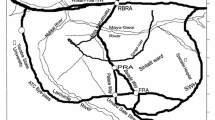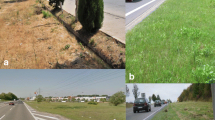Abstract
This work is a complementary investigation to the earlier urban soil survey for a rapidly growing city of relatively high traffic density. Therefore, it aims to apply the environmental magnetism approach to assess the roadside pollution at a known polluted site. The used magnetic proxies are the initial magnetic susceptibility and saturation magnetization. The results prove the applicability of this method in detecting roadside pollution. The shape and magnitude of the magnetic signals was affected by the topography and prevailing wind direction that caused the magnetic peaks to be shifted accordingly. Particle size was found to affect the magnetic material content, where sand size (63–150 μm) bears the highest magnetic signals relative to smaller silt size (<63 μm). The magnetic anomalies coincided positively with heavy metal pollution in the studied site, which might indicate that the magnetic materials serve as an effective proxy for the metallic pollution (i.e., Fe, Ni, Pb, Cu, and Zn) originated mainly from vehicular sources.




Similar content being viewed by others
References
Bityukova L, Scholgar R, Birke M (1999) Magnetic susceptibility as indicator of environmental pollution of soils in Tallinn. J Phys Chem Earth A 24(9):829–835
Culitty BD (1972) Introduction to magnetic materials. Addison-Wesley, Reading
Dearing JA, Hannam JA, Anderson AS, Wellington EMH (2001) Magnetic, geochemical and DNA properties of highly magnetic soils in England. Geophys J Int 144:183–196
Dekkers MJ, Pieterson HS (1992) Magnetic properties of low-Ca fly-ash: a rapid tool for Fe-assessment and a survey for potential hazardous elements. Mater Res Soc Symp Proc 245:37–47
El-Hasan T (2002) Urban geochemistry: heavy metals distribution on the soils of relatively heavy industrial city of Sahab, central Jordan. Mu’tah Lil-Buhuth wad-Dirasat 17(3):49–67
El-Hasan T, Lataifeh M (2003) Environmental magnetism: the implication of initial magnetic susceptibility and saturation magnetization for detecting roadside pollution in arid regions. Dirasat Pure Sci 30(2):191–202
Fassdinder JWE, Stanjeck H, Vali H (1990) Occurrence of magnetic bacteria in soil. Nature 343:161–163
Fialova H, Maier G, Petrovsky E, Kapicka A, Boyko T, Scholger R (2006) Magnetic properties of soils from sites with different geological and environmental settings. J Appl Geophys 59:273–283
Flanders P (1999) Identifying fly ash at a distance from fossil fuel power stations. Environ Sci Technol 33:528–532
Gautam P, Blaha U, Appel E, Neupane G (2004) Environmental magnetic approach towards the quantification of pollution in Kathmandu urban area, Nepal. Phys Chem Earth 29(13 and 14):973–984
Gautam P, Blaha U, Appel E (2005) Magnetic susceptibility of dust-loaded leaves as a proxy of traffic-related heavy metal pollution in Kathmandu city, Nepal. Atmos Environ 39:2201–2211
Georgeaud VM, Rochette P, Ambrosi JP, Vandamme D, Williamson D (1997) Relationship between heavy metals and magnetic properties in large polluted catchments: The Etang de Berre (South of France). Phys Chem Earth 22(1–2):211–214
Goddu SR, Appel E, Jordanova D, Wehland R (2004) Magnetic properties of road dust from Visakhapatnam (India)–relationship to industrial pollution and road traffic. Phys Chem Earth 29(13 and 14):985–995
Hanesch M, Maier G, Scholger R (2003) Mapping heavy metal distribution by measuring the magnetic susceptibility of soils. J phys 107(IV):605–608
Heller F, Strzyszcz Z, Magiera T (1998) Magnetic record of industrial pollution in forest soils of Upper Silesia, Poland. J Geophys Res 103(B8):767–774
Hoffman V, Hanzlik M, Wildner M, Horn P, Fehr K Th (1998) Cigarette lighters: a significant source of anthropogenic magnetic and REE bearing aerosol particles–a potential health risk? Geol Karpath 49(3):235–236
Hoffmann V, Knab M, Appel E (1999) Magnetic susceptibility mapping of roadside pollution. J Geochem Explor 66:31–326
Jaradat QA, Momani KA (1999) Contamination of roadside soil, plants, and air with heavy metals in Jordan, a comparative study. Turk J Chem 23:209–220
Jordanova NV, Jordanova DV, Veneva L, Yorova K, Petrovsky E (2003) Magnetic response of soils and vegetation to heavy metal pollution—a case study. Environ Sci Technol 37:4417–4424
KEVA (2003) Health impacts of Kathmandu’s air pollution. Report submitted to Kathmandu Electrical Vehicle Alliance (KEVA) by Clean Energy Nepal and Environmental and Public Health Organization, Kathmandu, 87pp (unpubl.)
King JW, Channel JET (1991) Sedimentary magnetism, environmental magnetism, and magnetostratigraphy. Rev Geophys Suppl 358–370
Knab M, Hoffmann V, Appel E, Jordanova N, Beck R (1998) Magnetic mapping of roadside pollution and correlation with heavy metals. Geol Karpath 49(3):237
Lataifeh M (1995a) High field magnetization measurements on holmium nicotinate dihydrate. Abhath Al-Yarmouk 4(1-B):41–49
Lataifeh M (1995b) Magnetization measurement on thulium nicotinate dihydrate compound. Mu’tah J res stud 10(2):89–96
Lecoanet H, Leveque F, Ambrosi JP (2001) Magnetic properties of salt-marsh soils contaminated by iron industry emissions (southeast France). J Appl Geophys 48:67–81
Leven C, Hoffmann V, Knab M, Appel E, Schaefer R, Beck R (1998) platinum group of elements (PGE) contamination of roadside soils: magnetic parameters as a proxy? Geol Karpath 49(3):238
Magiera T Strzyszcza Z, Kapickab A, Petrovsky E (2006) Discrimination of lithogenic and anthropogenic influences on topsoil magnetic susceptibility in central Europe. Geoderma 130:299–311
Morris WA, Versteeg JK, Bryant DW, Legzdins AE, McCarry BE, Marvin CH (1995) Preliminary comparisons between mutagenecity and magnetic susceptibility of respirable airborne particulate. Atmos Environ 29:3441–3450
Oldfield F (1991) Environmental magnetism—a personal prospective. Quaternary Sci Rev 10:73–85
Petrovsky E, Kapicka A, Jordanova N, Knab M, Hoffmann V (2000) Low-field magnetic susceptibility: a proxy method of estimating increased pollution of different environmental systems. Environ Geol (submitted)
Reynolds RL, King JW (1998) Magnetic records of climate change. Rev Geophys Suppl 165:101–110
Schafer J, Puchelt H (1998) Platinum-group-metals (PGM) emitted from automobile catalytic counters and their distribution in roadside soils. J Geochem Explor 64:214–218
Schmidt A, Yarnold R, Hill M, Ashmore M (2005) Magnetic susceptibility as proxy for heavy metal pollution: a site study. J Geochem Explor 85:109–117
Strzyszcz A, Magiera T (1998) Magnetic susceptibility and heavy metals contamination in soils of southern Poland. Phys Chem Earth 23(9–10):1127–1131
Versteeg JK, Morris WA, Rukavina NA (1995) The utility of magnetic properties as a proxy for mapping contamination in Hamilton Harbor sediment. J Great Lakes Res 21:71–83
Versteeg JK, Morris WA, Rukavina NA (1996) Distribution of contaminated sediment in Hamilton Harbor as mapped by magnetic susceptibility. Geosci Can 22(4):145–151
Zheng H, Oldfield F, Yu L, Show J, An Z (1991) The magnetic properties of particle sized samples from the Luo Chuan loess section: evidences for pedogenesis. Phys Earth Planet Inter (68):250–258
Acknowledgments
The Author is deeply grateful to Prof Dr Mahdi Lataifeh (Department of Physics, Mu’tah University) for his assistance in magnetic analysis and interpretation. Also the author would like to express his thanks to Prof S. Kembe, University of Darmstadt, Germany for his critical comments and revisions.
Author information
Authors and Affiliations
Corresponding author
Rights and permissions
About this article
Cite this article
El-Hasan, T. The detection of roadside pollution of rapidly growing city in arid region using the magnetic proxies. Environ Geol 54, 23–29 (2008). https://doi.org/10.1007/s00254-007-0789-4
Received:
Accepted:
Published:
Issue Date:
DOI: https://doi.org/10.1007/s00254-007-0789-4




